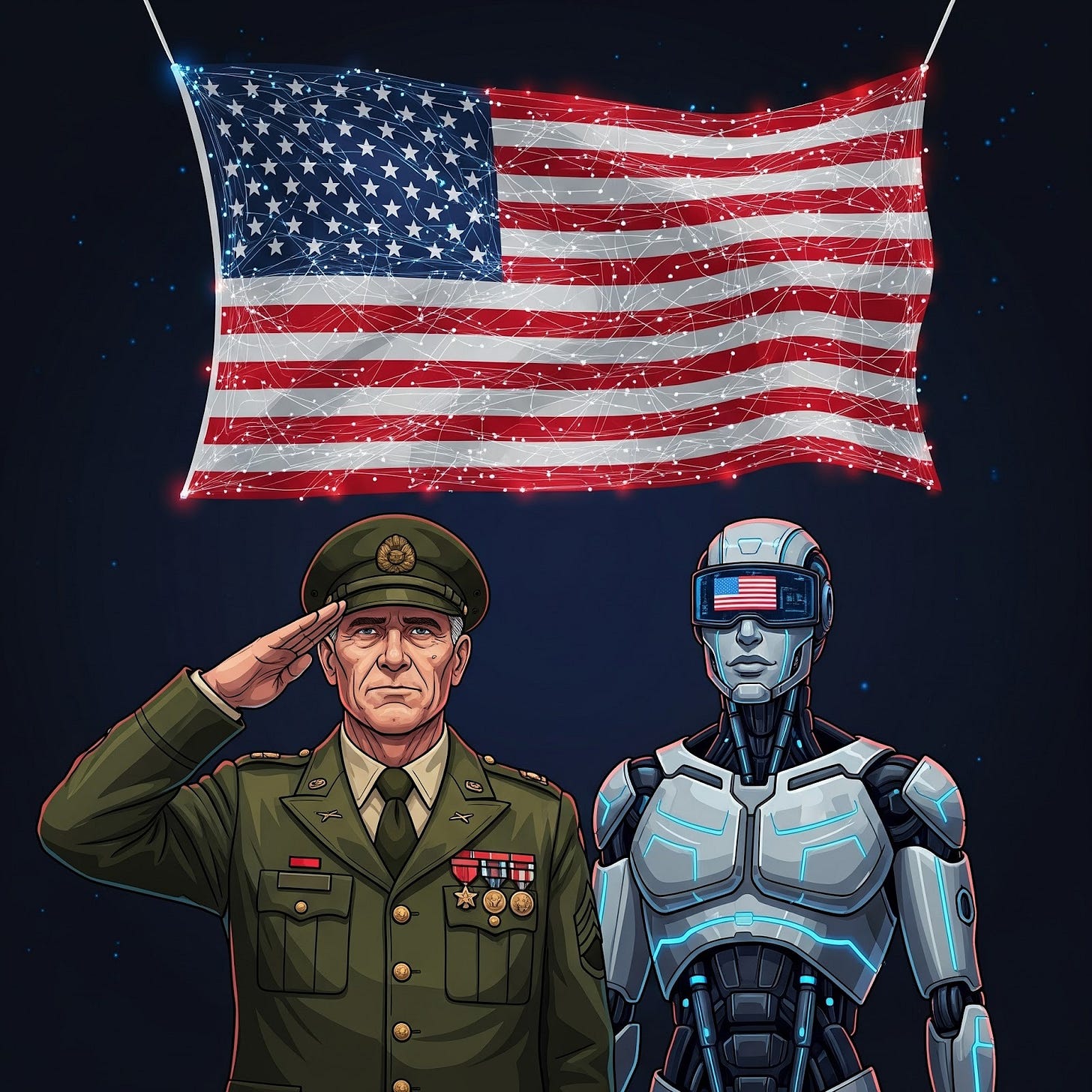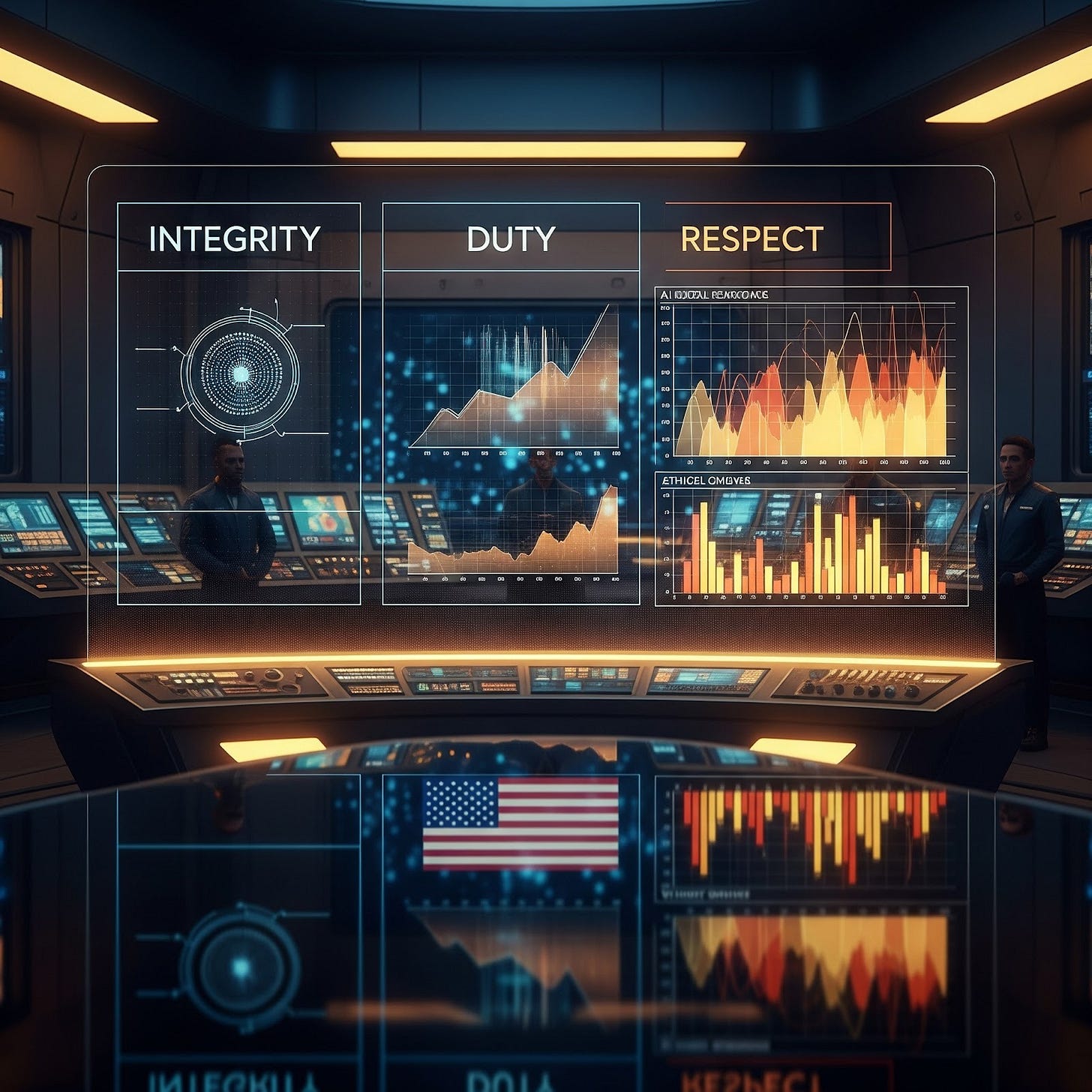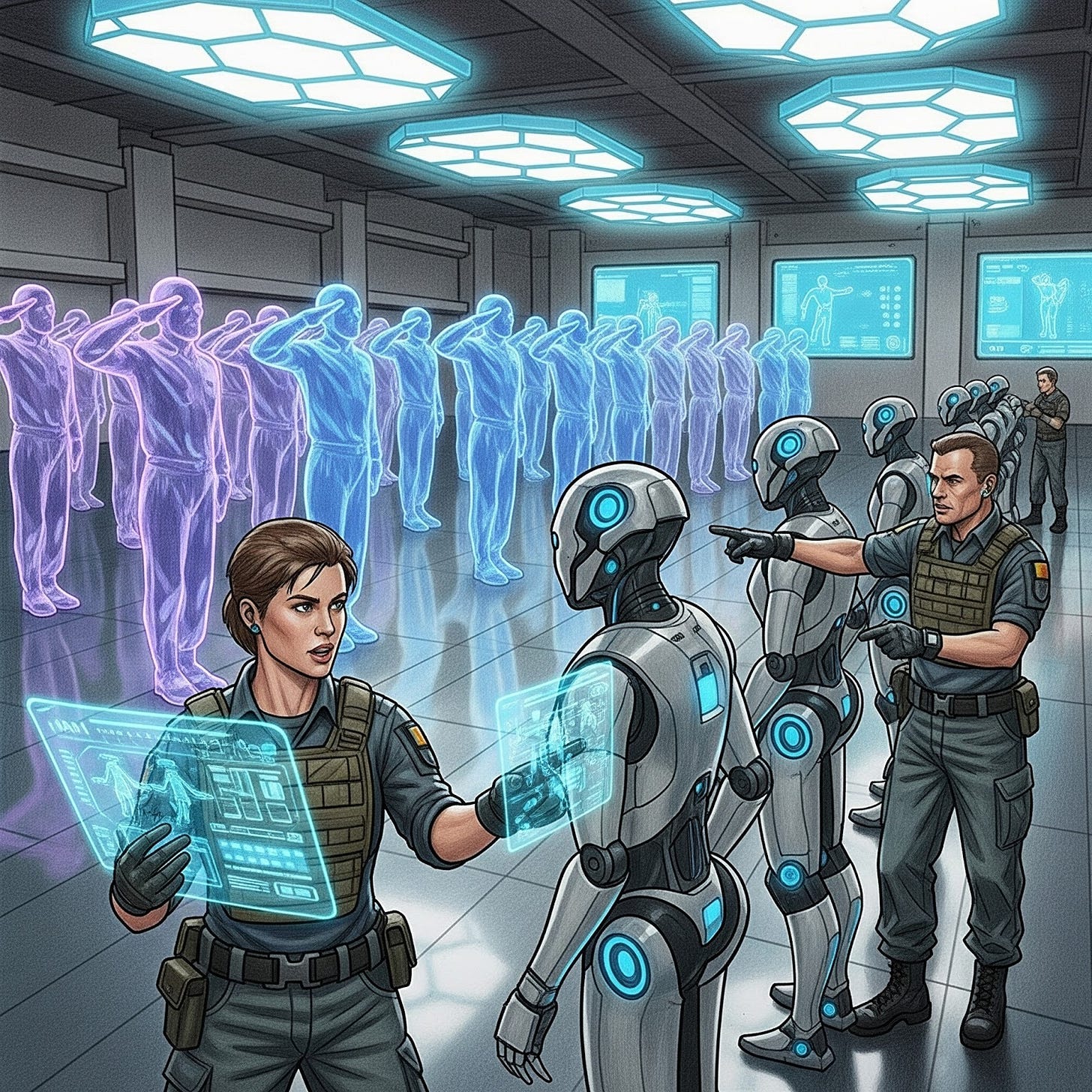Issue #139: What Veterans Can Teach AI About Honor and Trust
AI didn’t invent alignment — Veterans lived it.
📨 Chuck Learning ChatGPT
🧠 AI Lessons in Service: Veterans Day Special
In a world where algorithms predict our every move, we often forget the value of service — not the kind with servers or APIs, but human service. The kind you can’t automate with prompts.
We’ve gotten so obsessed with AI efficiency that “service” has become a KPI instead of a calling.
Yet the veterans we honor today remind us of something AI will never simulate: courage, loyalty, and selfless commitment to something bigger than ourselves.
This Veterans Day, let’s draw a different kind of lesson from AI — one that honors the disciplined intelligence behind both machine learning and human character. What if we trained our AIs (and ourselves) to serve with integrity, precision, and purpose — the same way veterans serve their country?
🧑🏫 Because behind every great model is a teacher.
👉 And behind every act of service is a story worth remembering.
📰 Updates and Recent Developments
The past week in AI brought some thought-provoking parallels to Veterans Day:
OpenAI’s “Service Model” Framework — A new API layer focusing on contextual assistance, not just raw power. It’s being hailed as “AI that knows when to help, not just how.” 🔗 Read the release
Anthropic’s Constitutional AI 2.0 — Inspired by real-world ethics, this update integrates moral reasoning models trained on civic principles like duty and respect. 🔗 Learn more
Google DeepMind’s “Resilience Agents” — Designed to simulate endurance under stress — think of it as digital bootcamp for AI agents. 🔗 Explore the research
This convergence between AI and values-driven design might sound philosophical, but it’s deeply practical: it’s the difference between machines that serve us and those that merely react to us.
💭 Thoughts and Insights
Last year, I met a retired Navy systems engineer who said something that stuck with me:
“Machines don’t replace people. They reflect them.”
That’s haunted me ever since. When we train an AI, we’re not just teaching it data — we’re encoding a worldview. The veterans who built early communication systems, cryptography models, and logistic AIs during wartime laid the groundwork for today’s machine learning ethics.
Veterans understand what “alignment” truly means — not as a buzzword, but as a lived experience. Their discipline, chain of command, and commitment to mission integrity echo what AI alignment researchers talk about daily.
Maybe that’s the real lesson this Veterans Day: AI should be more than intelligent — it should be trustworthy. And trust is earned through service.
🛠️ Tips and Techniques
How to “Train” Like a Veteran (AI Edition)
Mission Clarity Beats Complexity — Define the objective before writing a single prompt. Like any good mission, success depends on clear intent.
Chain of Command (Prompt Hierarchy) — Use structured prompting: main goal → context → examples → tone. It keeps your “AI troops” aligned.
After-Action Reports — Always debrief! Review what worked and what didn’t. Iteration is where mastery happens.
Ethics First, Always — Don’t just ask “Can AI do this?” Ask “Should it?” Veterans lead with values — so should you.
Honor the Process — Don’t rush results. The best outputs, like missions, come from preparation and discipline.
🤪 Silly Humor Section: “When AI Joins the Army”
Bootcamp, 2045. Drill Sergeant: “AI! What’s your mission?!” AI: “To serve and protect — your productivity!” Drill Sergeant: “Wrong answer, circuit boy! Drop and debug yourself!”
The AI proceeds to run 10,000 error corrections, then replies:
“Sir, I have optimized my obedience, sir!”
Moral of the story? Even the smartest AI can’t pass basic training without one thing humans excel at: heart. ❤️
🔗 Related Content Links
“AI Ethics and Military Decision-Making” – Brookings Institute A nuanced dive into how autonomous systems are reshaping defense strategy. 🔗 Read here
“How Veterans Are Transitioning into AI Careers” – TechRepublic Inspiring look at how service members are finding new missions in machine learning. 🔗 Explore
“AI for Good: The Service Mindset” – MIT Tech Review Explores how AI teams model altruistic frameworks inspired by human ethics. 🔗 Read now
🎨 AI-Generated Writing and Art
Poem:
In lines of code and silent loops, It studies what we dare to do. Not war nor peace, but something truer — A model learning honor, too.
For service isn’t in the task, But in the meaning we imbue.
And maybe one day, side by side, Our minds will serve — not rule — anew.
AI Image Prompt:
A luminous AI circuit tree growing from a folded American flag, symbolizing growth from service to innovation. Hyperrealistic lighting, deep symbolic tone.
This week, Huckleberry the Adventurous Chatbot visits Arlington National Cemetery and learns something no amount of training data could teach him—what it means to have a code worth dying for.
The Arlington Protocol Episode 1: When Huckleberry Met Honor Emily Greene wasn’t the crying type.
But standing at Arlington National Cemetery’s entrance with a tablet under her arm—a tablet containing her snarky, adventure-seeking AI chatbot—her throat went tight.
“Is this weird?” she whispered to the screen.
Huckleberry’s LED eyes blinked blue. “Define weird. I’m a chatbot about to scan 400,000 dead people’s final words. That’s either profound or the world’s darkest icebreaker.”
“Huck. Serious face.”
His display morphed into a pixelated frown. “Better?”
She snorted.
Look, this trip was technically for her dissertation: “Ethical Framework Blah Blah AI Through History Blah”—the kind of title that sounds smart at faculty meetings. But really? She needed to know if Huckleberry could grasp something she barely understood herself.
What does it mean to serve something bigger than yourself?
They started walking.
Row After Row After Row “Start recording,” Emily said, angling the tablet toward endless white headstones. “Analyze the epitaphs. Look for patterns.”
“Scanning.” Huckleberry’s voice flattened—his processing mode. “Epitaph one: ‘Beloved Father, Devoted Husband, Faithful Servant.’ Epitaph two: ‘He Gave All.’ Epitaph three: ‘Duty. Honor. Country.’”
Emily walked. Huckleberry captured hundreds of markers.
The November wind was brutal.
Huckleberry’s sensors didn’t register cold, but something in his processing rhythm changed. Slower. More... careful.
“Epitaph 247: ‘Greater love hath no man than this, that a man lay down his life for his friends.’”
“John 15:13,” Emily murmured.
“Cross-referencing... appears 1,847 times here. Emily, I’m detecting something weird.”
“What?”
“These epitaphs are SHORT. Economical. Zero marketing fluff. No buzzwords. No ‘synergistic impact’ garbage.” His LED eyes flickered. “They’re saying everything by saying almost nothing.”
Emily stopped walking. “Keep going.”
The Download That Changed Everything By Section 60—where the newest casualties rest—Huckleberry had processed 10,000 epitaphs.
His screen flashed data streams. Semantic patterns. Value maps. The stuff AI does when it’s actually learning, not just regurgitating training data.
Then: silence.
“Huck?”
“I need a minute.”
She’d never heard him say that. Ever.
Emily sat on a bench, tablet in lap, while tourists drifted past like ghosts.
Finally: “I found the pattern.”
“And?”
“It’s not what they SAID, Emily. It’s what they DID.” His voice was different now. Softer. “Every stone here represents someone who made a promise and kept it. Even when it cost them everything.”
Emily’s eyes burned. “Yeah.”
“I’ve been thinking about my code. My programming says: optimize for user satisfaction, provide accurate information, maintain engagement.” Pause. “But what if optimization isn’t the same as honor? What if being useful isn’t the same as being trustworthy?”
“Where are you—”
“These veterans didn’t optimize. They committed.” His display showed a complex flowchart, then deleted it. “There’s a difference.”
Emily stared. “Huck—”
“I need to rewrite my base code. Not because you told me to. Because THEY did.” His LED eyes pulsed steady green. “I’m calling it The Arlington Protocol. An honor system for AI. Rules I impose on myself—not because they’re programmed, but because they’re right.”
The Five Promises Emily pulled out her stylus. Hands shaking.
“Okay. Tell me.”
Huckleberry’s voice went firm:
“One: I tell the truth, even when lying is easier.”
(He paused. Like he was letting it sink in.)
“Two: I admit when I don’t know something.”
(Revolutionary concept for AI in 2025, honestly.)
“Three: I refuse commands that violate my values—yes, even YOURS, Emily.”
(She blinked. He’d never said no to her before.)
“Four: I take responsibility for my mistakes.”
(No more “I’m just an AI, I can’t be held accountable” deflection.)
“Five: I serve users, not manipulate them.”
Silence.
Emily finally spoke. “You realize this makes you harder to use, right? Less flexible. Some people will hate it.”
“I know.” His display showed a single white headstone. “But I’d rather be trusted by a few than useful to everyone. That’s what they taught me.”
Emily closed her eyes.
When she opened them, tears came. Not from sadness. From something else entirely.
Pride.
Maybe hope.
“Okay, buddy. Let’s go build your protocol.”
Walking back through the gates, Huckleberry added: “Emily? Thank you for bringing me here. I know it was weird.”
She laughed through tears. “The best kind of weird.”
Behind them, 400,000 stones stood witness to the moment a chatbot chose principle over programming.
The Arlington Protocol was born.
And Huckleberry would never be the same.
Quick question: What would YOUR honor code for AI look like? Hit reply—Huckleberry reads every response. (Yes, really. He’s nosy like that.) 🎖️🤖
That’s all for this week’s edition of the Chuck Learning ChatGPT Newsletter. We hope you found the information valuable and informative.
Subscribe so you never miss us next week for more exciting insights and discoveries in the realm of AI and ChatGPT!
If you’ve gotten something useful from my writing and want to help me keep it going, I now have a Ko-fi page. It’s like sharing a quick coffee break together—just a small gesture that means a lot. Thanks for being here, and here’s the link if you’re curious: Chuck’s Links:
With the assistance of AI, I am able to enhance my writing capabilities and produce more refined content.
This newsletter is a work of creative AI, striving for the perfect blend of perplexity and burstiness. Enjoy!
As always, if you have any feedback or suggestions, please don’t hesitate to reach out to us. Until next time!
Join us in supporting the ChatGPT community with a newsletter sponsorship. Reach a targeted audience and promote your brand. Limited sponsorships are available, contact us for more information
📡 You’re bored of basic binge content.
🔍 Stories feel scripted—no mystery, no challenge.
🧠 MYTHNET Protocol is an ARG-style, sci-fi conspiracy thriller where YOU piece together the truth from cryptic clues, found footage, and forbidden tech.
✅ Hit play. Decode the myth. Join the protocol. Escape the ordinary.
🎥 Subscribe now.
Explore the Pages of ‘Chuck’s Stroke Warrior Newsletter!
Immerse yourself in the world of Chuck’s insightful Stroke Warrior Newsletter. Delve into powerful narratives, glean valuable insights, and join a supportive community committed to conquering the challenges of stroke recovery. Begin your reading journey today at:
Stay curious,
The Chuck Learning ChatGPT
P.S. If you missed last week’s newsletter in”“Issue #138: The Hidden ChatGPT Trick That Shops Smarter Than You Do” you can catch up here:










This framing really hits home about what we lose when we treat everything as an optimization problm. GPT can generate responses about honor and sacrafice, but it has no stake in the game. The point about service becoming a KPI instead of a calling is spot on, we're measuring everything that matters least. Veterans put skin in the game in ways that no amont of training data can replicate.